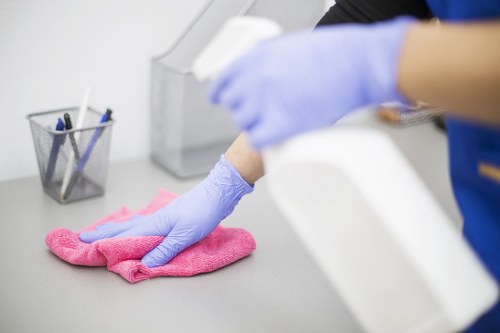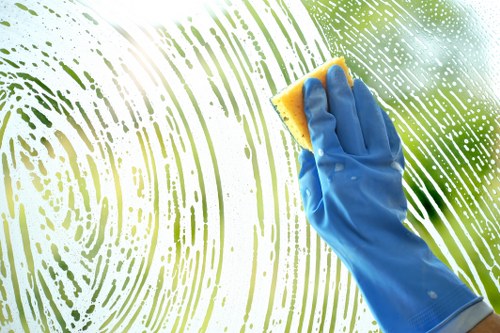Deep Cleaning Burnt Oak: A Comprehensive Guide

Burnt Oak is a beautiful area known for its charming homes and vibrant community. Maintaining the cleanliness of your home here not only preserves its beauty but also ensures a healthy living environment. Deep cleaning burnt oak surfaces can be a daunting task, but with the right approach and tools, you can achieve excellent results.
In this guide, we’ll walk you through the best practices for deep cleaning burnt oak. Whether you’re dealing with stubborn stains, accumulated dirt, or simply want to refresh your space, these tips will help you restore the natural beauty of your oak surfaces.
Before diving into the cleaning process, it's essential to understand the characteristics of burnt oak. This unique finish not only adds a rustic charm but also requires specific care to maintain its appearance.

Understanding Burnt Oak
Burnt oak is a type of hardwood that has undergone a special burning process to achieve its distinctive darkened finish. This process not only enhances the wood’s natural grain but also provides a durable and resilient surface.
The burning process creates a protective layer on the wood, making it more resistant to scratches and stains. However, this also means that certain cleaning methods may not be suitable. Knowing how to care for burnt oak properly is crucial to maintaining its elegance and longevity.
Unlike other finishes, burnt oak requires gentle cleaning agents that won’t strip away the protective layer. Using the wrong products can lead to discoloration or damage, so it’s important to choose your cleaning supplies carefully.

Essential Tools for Deep Cleaning Burnt Oak
To effectively deep clean your burnt oak surfaces, you will need a few essential tools and cleaning agents. Having the right equipment on hand makes the process smoother and more efficient.
Cleaning Supplies
- Microfiber Cloths: Perfect for dusting and wiping surfaces without leaving scratches.
- Soft-Bristle Brushes: Ideal for scrubbing away dirt without damaging the wood.
- Mild Detergent: A gentle cleaner that won’t harm the oak finish.
- White Vinegar: An effective natural cleaner for stubborn stains.
- Olive Oil: Helps to condition the wood after cleaning.
Having these tools ready will prepare you for a thorough and safe cleaning process.
Additionally, consider using protective gloves to keep your hands safe from cleaning agents, and ensure adequate ventilation in the area you’re cleaning.

Step-by-Step Deep Cleaning Process
Follow these steps to deep clean your burnt oak surfaces effectively:
1. Dusting and Initial Cleaning
Begin by removing any loose dust and debris from the surface using a microfiber cloth. This helps prevent scratching the wood during the cleaning process.
For crevices and intricate designs, use a soft-bristle brush to ensure all dust is eliminated.
2. Preparing the Cleaning Solution
Mix a mild detergent with warm water to create your cleaning solution. Alternatively, you can use a mixture of white vinegar and water for a natural approach.
A drop or two of olive oil can be added to the solution to help condition the wood.
3. Cleaning the Surface
Dampen a microfiber cloth with your cleaning solution and gently wipe the oak surface. Avoid soaking the wood, as excessive moisture can cause damage.
For stubborn stains, apply the solution and let it sit for a few minutes before gently scrubbing with a soft-bristle brush.
4. Rinsing and Drying
After cleaning, use a separate cloth dampened with clean water to wipe away any residue from the cleaning solution.
Dry the surface thoroughly with a dry microfiber cloth to prevent moisture buildup.
5. Conditioning the Wood
Once the surface is clean and dry, apply a small amount of olive oil to a cloth and gently rub it into the wood. This helps to restore the wood’s natural shine and protect the finish.
Allow the oil to absorb for a few hours before using the surface.

Maintenance Tips for Burnt Oak
Keeping your burnt oak surfaces clean requires regular maintenance. Here are some tips to help you maintain their beauty:
- Regular Dusting: Dust your surfaces at least once a week to prevent the buildup of dirt and grime.
- Immediate Spill Cleanup: Wipe up any spills immediately to prevent stains from setting in.
- Avoid Harsh Cleaners: Stick to mild detergents and natural cleaners to protect the wood finish.
- Use Coasters and Mats: Protect surfaces from scratches and moisture damage by using coasters and mats.
- Condition Periodically: Apply olive oil or a wood conditioner every few months to keep the wood nourished and shiny.
By following these maintenance tips, you can ensure that your burnt oak surfaces remain beautiful and well-preserved for years to come.
Additionally, consider using furniture covers or protective pads in high-traffic areas to minimize wear and tear.

Common Stains and How to Remove Them
Even with regular maintenance, stains can sometimes occur on burnt oak surfaces. Knowing how to address these stains promptly can save your wood from permanent damage.
Coffee and Tea Stains
These dark beverages can leave noticeable stains on your oak surfaces. To remove them, create a solution of equal parts white vinegar and water. Apply the solution to the stain using a soft cloth and gently rub in the direction of the wood grain.
Grease and Oil Stains
Grease and oil can penetrate the wood, causing stubborn stains. Sprinkle baking soda on the stain and let it sit for 15 minutes to absorb the oil. Then, wipe away the baking soda with a damp cloth.
Ink Stains
For ink stains, use rubbing alcohol applied to a cotton ball. Gently blot the stain without rubbing, which can spread the ink further.
Water Rings
Water rings are caused by moisture trapped under the finish. To remove them, place a clean cloth over the stain and use an iron on a low setting. Gently press for a few seconds to transfer the moisture from the wood into the cloth.
Rust Stains
Rust can discolor oak surfaces. Apply lemon juice mixed with salt to the stain, let it sit for a few minutes, and then wipe it away with a damp cloth.

Professional Deep Cleaning Services in Burnt Oak
While DIY cleaning can be effective, certain situations may require professional assistance. Professionals have the expertise and equipment to handle deep cleaning tasks that are beyond the scope of regular maintenance.
Hiring a professional ensures that your burnt oak surfaces are cleaned thoroughly without the risk of damage. They can also provide specialized treatments to restore and protect your wood.
When to Consider Professional Help
- Severe Stains: Deep or persistent stains may require specialized cleaning solutions.
- Extensive Damage: Cracks, scratches, or other damage might need professional repair.
- Regular Maintenance: Professional services can offer regular maintenance plans to keep your oak surfaces in top condition.
- Restoration Projects: If you’re renovating or restoring your home, professionals can ensure the wood is properly treated and preserved.
When selecting a professional cleaning service in Burnt Oak, look for companies with experience in handling hardwood surfaces. Check reviews and ask for recommendations to find a reliable provider.
Investing in professional services can save you time and provide peace of mind, knowing that your burnt oak is in expert hands.

Eco-Friendly Cleaning Solutions
Choosing eco-friendly cleaning solutions is beneficial for both your health and the environment. Many conventional cleaning products contain harsh chemicals that can damage your burnt oak and contribute to pollution.
Here are some eco-friendly alternatives you can use:
- White Vinegar: A natural disinfectant and degreaser that’s safe for wood surfaces.
- Baking Soda: Effective for removing stains and neutralizing odors.
- Lemon Juice: Acts as a natural bleach and helps to remove stains.
- Olive Oil: Conditions and polishes the wood without harsh chemicals.
These natural ingredients are not only effective but also safer for households with children and pets. They also reduce your environmental footprint by minimizing the use of synthetic chemicals.
Incorporating eco-friendly cleaning methods into your routine is a simple way to maintain your burnt oak while being kind to the planet.

Preventing Future Damage
Preventing damage to your burnt oak surfaces is just as important as cleaning them. Implementing preventive measures can extend the life and beauty of your wood.
Use Protective Pads
Place protective pads under furniture legs to prevent scratches and dents. This is especially important for heavy furniture that can cause significant damage over time.
Avoid Direct Sunlight
Too much exposure to direct sunlight can fade and discolor burnt oak. Use curtains or blinds to protect your surfaces from prolonged sunlight.
Control Humidity Levels
Fluctuating humidity can cause wood to expand and contract, leading to cracks and warping. Use dehumidifiers or humidifiers to maintain a stable indoor environment.
Regular Inspections
Periodically inspect your oak surfaces for any signs of damage or wear. Addressing minor issues early can prevent them from becoming major problems.
Proper Ventilation
Ensure that areas with burnt oak have proper ventilation to prevent moisture buildup, which can lead to mold and mildew growth.

Decorating Tips for Burnt Oak
Enhancing the aesthetic appeal of your burnt oak surfaces can elevate the overall look of your home. Here are some decorating tips to complement your deep-cleaned oak:
- Natural Elements: Incorporate plants and flowers to add a fresh contrast to the dark oak.
- Metal Accents: Use metal fixtures and decorations to create a modern contrast with the rustic oak.
- Textiles: Add colorful or patterned textiles like rugs and cushions to brighten the space.
- Lighting: Use warm lighting to highlight the rich tones of the burnt oak.
- Art Pieces: Display artwork that complements the warm hues of the wood.
By thoughtfully decorating your space, you can create a harmonious environment that showcases the beauty of your burnt oak surfaces.
Experiment with different textures and materials to find the perfect balance that suits your personal style.

Local Insights: Cleaning Services in Nearby Areas
Burnt Oak is surrounded by several neighboring areas, each offering unique features and professional deep cleaning services to cater to your needs.
- Tottenham: Just a short drive away, Tottenham provides specialized hardwood cleaning services with eco-friendly options.
- Whetstone: Known for its reliable local cleaners who excel in maintaining burnt oak finishes.
- Finchley Road: Offers a range of professional cleaning services, including deep cleaning and restoration for burnt oak surfaces.
- North Finchley: Access to top-rated cleaning professionals who use advanced techniques to preserve wood beauty.
- Wood Green: Features expert services focused on both residential and commercial burnt oak cleaning needs.
- Colindale: Provides affordable and effective cleaning solutions tailored to burnt oak care.
- Burntwood: A hub for specialized wood cleaning services, ensuring thorough and safe maintenance.
- Mill Hill: Access to experienced cleaners who understand the nuances of burnt oak preservation.
- Hendon: Offers bespoke cleaning services that cater to the specific requirements of your wood surfaces.
- West Hendon: Known for its attentive and detail-oriented cleaning professionals.
- Childs Hill: Provides comprehensive cleaning packages that include deep cleaning and regular maintenance.
- Cricklewood: Features eco-friendly cleaning options that are safe for your family and the environment.
- Kentish Town: Offers a blend of traditional and modern cleaning techniques to maintain burnt oak.
- Colindale: Ensures high-quality cleaning services with a focus on customer satisfaction.
No matter where you are in or around Burnt Oak, you can find a professional cleaning service that meets your specific needs and helps keep your burnt oak surfaces looking their best.
Exploring these nearby areas for cleaning services can provide you with more options and potentially better pricing or specialized services.

Conclusion
Deep cleaning burnt oak is essential for preserving its beauty and ensuring a healthy living environment. By understanding the unique properties of burnt oak and using the right cleaning techniques and tools, you can maintain your surfaces effectively.
Regular maintenance, coupled with professional services when needed, will keep your burnt oak looking stunning for years to come. Additionally, incorporating eco-friendly cleaning solutions and preventive measures can enhance the longevity and appeal of your wood surfaces.
Remember, the key to successful deep cleaning is consistency and using the appropriate methods tailored to burnt oak. With the tips and strategies outlined in this guide, you’re well-equipped to tackle any cleaning challenges and keep your home in Burnt Oak sparkling clean and beautiful.

Frequently Asked Questions
1. How often should I deep clean my burnt oak surfaces?
It is recommended to deep clean your burnt oak surfaces at least twice a year. Regular maintenance between deep cleans, such as weekly dusting and immediate spill cleanup, will help keep the wood in excellent condition.
2. Can I use bleach to clean burnt oak?
No, bleach is too harsh for burnt oak and can damage the wood’s finish. Instead, opt for mild detergents or natural cleaning solutions like white vinegar and baking soda.
3. How do I remove scratches from burnt oak?
For minor scratches, apply a small amount of olive oil or a wood conditioner and gently rub it into the scratch. For deeper scratches, you may need to sand the area lightly and apply a matching wood stain.
4. Is it safe to use commercial wood cleaners on burnt oak?
While some commercial wood cleaners are safe, it’s important to choose products specifically designed for hardwood and avoid those with harsh chemicals that can strip the wood’s protective layer.
5. What should I do if my burnt oak surface is severely damaged?
If your burnt oak surface is severely damaged, it’s best to consult a professional cleaning or restoration service. They can assess the damage and recommend appropriate treatments to restore the wood.


